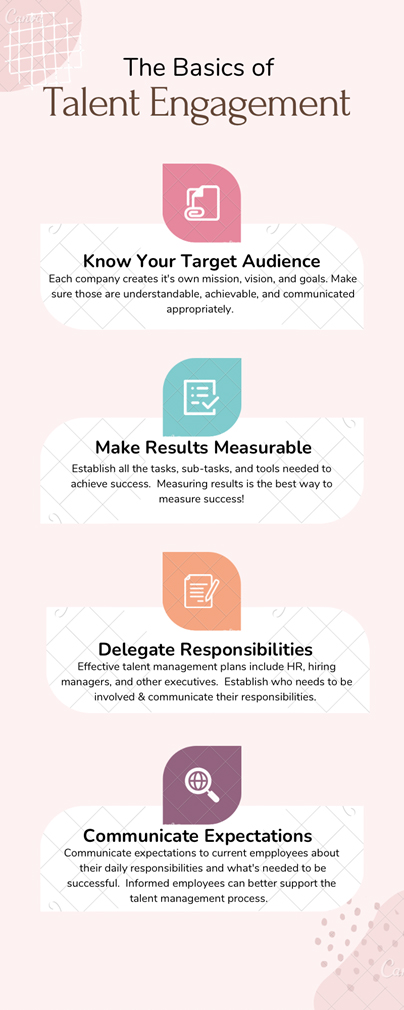By: Felecia Brasfield
To find and retain dedicated employees, a company needs to have an efficient talent engagement process. A recent Gallup report, State of the Global Workplace, revealed that 85% of employees are ‘not engaged’ or actively disengaged at their respective jobs. This sets the stage for a competitive job market that companies need to consider during hiring and onboarding. Therefore, building talent engagement processes are necessary to attract skilled and dedicated employees.
Simply put, talent engagement is the act of recruiting and keeping employees. The organization needs to communicate that they value their current and future employees. As a result, engaged workers tend to stay with a company longer than those who feel underappreciated. But why else is talent engagement so vital to organizational success?
The Impact of Talent Engagement
A viable talent engagement process focuses on the company’s most valuable resources, the employees themselves. Engagement plans help by increasing employee performance and productivity. Not just individual performance but also higher functioning teams within the organization. Retaining current employees and hiring exceptional talent is easier when appropriate strategies are in place.
Building talent engagement processes provides the opportunity to create a solid company brand. As workers search for new jobs, they gravitate toward companies that make informative and seamless onboarding processes. In addition, well-established company branding attracts more qualified candidates.
Lucrative engagement plans help the company stay competitive within its industry. In addition, an organization that works to develop its employees is more prepared to face future challenges.
Talent Engagement Essentials
It’s imperative to know what strategies and processes are already in place before making any alterations or additions. Attracting, onboarding, engaging, and retaining talent is part of the employee lifecycle within any organization. This process needs to be well-established and reliable.
Essential Processes & Procedures
- Execute an Audit – Make sure that there’s some type of Customer Relationship Manager (CRM) software. CRMs provide a one-stop-shop for managing candidates and the entire talent management lifecycle. It gives HR and hiring managers the ability to track candidate information and how quickly the company responds to each candidate.
- Ensure Open Positions are Readily Available – Denote where open positions are listed to the general public, such as the company website, third-party hiring sites, or job boards. Then determine how easily they are to access, taking into account the platform interface with mobile devices.
- Update the Information on the Career Page – All information should be up to date and provide valuable information about the company culture to potential applicants. In addition, it should communicate anything special about the company and what it’s like to work there. It’s also helpful to have any company mission and vision statements on the career page and a link to company leadership.
- Leverage Social Media Accounts – Check the company’s social media accounts to see how many individuals follow the company and interact with posts. When posting open positions, constantly check comments, shares, and likes.
How to Improve Employee Engagement
Over time each company determines what works to best accomplish its goals. There are several key elements that many talent engagement plans utilize for the best return rates.
- Create Referral Programs – Current employees may know someone they could recommend for open positions. Establish employee referral programs to make it easy for workers to refer friends and acquaintances.
- Build Up Company Branding – Strengthen company brands and ensure the same messaging and branding are succinct across all marketing and media outlets.
- Engage Candidates Positively – Consider including positive reviews from new hires or other industry leaders. These communicate to potential applicants the excellent reputation and positive experience they can expect from working with the company.
- Increase Employee Development – Always try to make training opportunities and programs available to current employees, especially new hires. Encouraging workers to educate themselves continually creates better personal and professional development.
- Plan for Success – Effective talent management plans incorporate current employees. Employees who continually learn and educate themselves can fill in skill gaps quickly when positions become available.
Need To Fill Roles At Your Company?
Fill Out Our Employee Request Form
Moving Forward with Talent Engagement
Companies shouldn’t rely solely on HR to manage the talent engagement lifecycle. Strategies need to be tailored to individual business needs and company goals. Successful talent engagement processes are crucial in identifying and hiring top talent.
Remember these keys to success:
- Be Positive by communicating to current employees and potential candidates that the company values them.
- Be Deliberate by setting achievable and measurable goals.
- Be Active by assigning tasks in advance and keeping everyone in the loop.



Leave a Reply